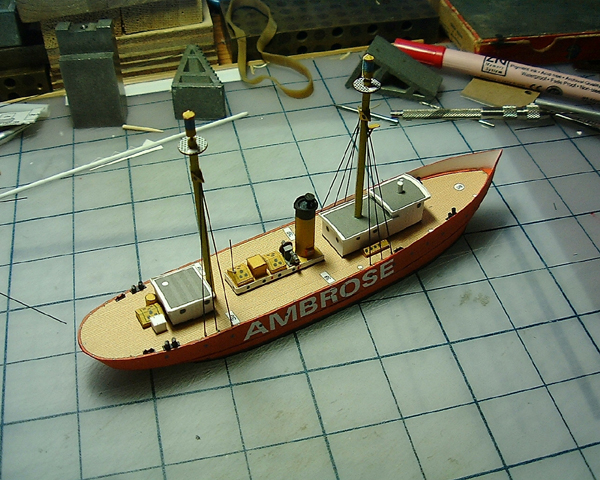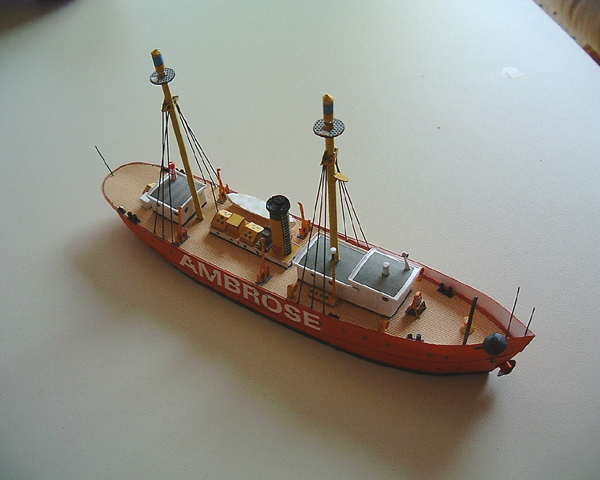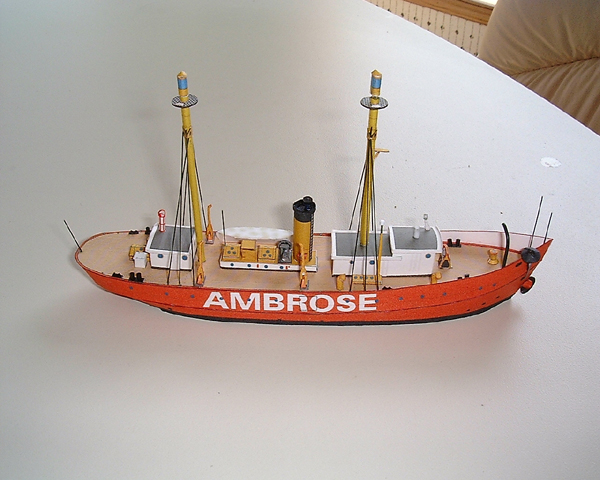

Lightship Ambrose
Roman Detyna, of Digital Navy, has done it again, by producing another fine model and itís comes as a free download from the Digital Navy Web Site. http://www.digitalnavy.com/†
Romanís new model is the American Lightship Ambrose; which is now a museum ship in New York City.
Building the Ambrose was fun; and requires some study of the parts and how they relate to the construction of the model before beginning.† A suggestion, before starting the model, drawing reference lines on a few parts will help in making sure they are cutout correctly. These would be part numbers 14b, 34 34b, 40 and 41.
The Hull framing is good and requires nothing special.† Due to the hull sides that are split horizontally, Roman has supplied a horizontal mating strip.† As I do not assemble my hulls according to norm, I opted not to use this mating strip. Even without the hull sides mated perfectly.† When cutting the hull out, cut both ends on the outside of the line as the fit is so precise that even a (mm) off and the hull will not mate to its other side.† When I build the next Ambrose, I will print the hull on 80 or maybe 100 lb stock for additional strength, although this may not be necessary if you use Romanís strip.
The deck attaches the way it is suppose to with the main deck resting on the hull top while the bow section fits up inside the hull.† Be careful to make sure all holes have been cut out; this also applies to the hull sides.† I forgot the anchor chain hole on my model and I will have to figure out how to cover this mistake.
The main cabin comes next and here it is important to watch for the tiny fillets that go around the roof on the outside.† They are printed in a very light gray almost invisible to the eye until you look carefully. Their part numbers are: 13e, 13f and 14c.† The roof also has a white area on the outside and likewise the outline is almost invisible to see.† Perhaps here if Roman had put reference lines as to where to cut it would make it a little easier.† Study the photos and you can see the white edge on the roof.† A unique idea in attaching the cabin to the hull is the use of separate tabs that are cut out and glued to the outline on the deck; then the cabin is slid over the tabs to mate with the deck.
The after cabin assembles the same as the main cabin but you need to pay attention as to which end faces the front.† Look at the photos and the model on the web site. A better idea might just be to save the image to disk and then print out the pictures to have as handy reference.† The center cabin presents no problem. Here however; I took scrap cardboard from my supply and built layers to make up the thickness I needed then wrapped the bulkhead around, added the roof and glued in placed.† Most of the remaining parts are assembled in the normal manor and present no problems.
†I could not figure why the mast should be doubled, as that would make it extremely difficult to roll.† I assume it was done to support the wire that is needed to hold the light.† I chose not to double mind, but rolled it in the usual manor.† I next took part 24a/25a (two small circles) and made two additional sets.† One I attached to the top of the mast as indicated and the other to the bottom of the mast.† Then I inserted a length of wire as long as the mast with an additional amount protruding above as indicated in the drawing.† (By the way, your local florist carries a nice array of wires, stop by and you can usually purchase a handful of different sizes for a quarter or so.)† This allows for the wire to go down the center of the mast and remain centered on the top where the light will be attached.† I did the same with the light by putting this part on the bottom of the light for the wire to enter and stop at the top of the copula keeping the whole assembly in-line.
As I mentioned in earlier reviews, I donít really care if my model is a multimedia model or not.† As long as the end results look good itís okay with me. Having said that, parts numbered 34 and 38 were plastic rod painted.† Likewise several of the pipes were made from plastic or wire.
Completing the model goes fairly easy with my only problem being the small size of some of the parts.† The ships bell gave me the biggest problem. †I formed it to look somewhat like a bell as close my aged fingers would allow.† After gluing the bell stand, the bell was then too large to fit inside.† In my future, I try for a bell off some ďNĒ gauge train engine.† The ratlines are beyond my skill level, so I opted to use fine wire to represent them.† Having finished the model now, I can leave finial rigging for a later date.† I will probably add railing around the fore and aft cabins and along the main deck as indicated in the photos.† The mistake I made in failing to cut out the anchor chain hole in the hull as mentioned earlier was solved by painting it black and then putting a piece of stretched plastic sprue, shaping it to look like it came out of the hull and attached to the anchor.
Roman has done us a great favor in producing a fine model that can be downloaded free and if you have the right computer software, the model can be enlarged or reduced to a much larger or smaller size like 1:350 or 1:700 for example.



This page was created by:
Saul H. Jacobs M.Ed.
Avionics Specialist, United States Air Force (Retired)
Microcomputer Technology, Pima Community College (Retired)
Tucson Arizona